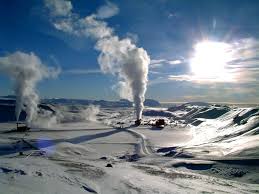The key to unlocking cleaner energy might be in our DNA, according to a new study by Stanford scientists. By combining synthetic DNA with microscopic particles, geothermal energy researchers at the university hope to tap into the widely available but often overlooked cleaner energy source all over the world.
WHAT IS GEOTHERMAL ENERGY?
Geothermal energy is thermal energy generated from within the Earth,
according to BCC Research analyst Aneesh Kumar. Geothermal energy is clean and sustainable compared to other sources of energy. The various sources of geothermal energy include radioactive decay occurring in the Earth’s crust, extremely high-temperature magma, shallow grounds and hot rocks and hot water found beneath the Earth’s surface.
The three main applications of geothermal energy include direct usage, geothermal heat pumps and electricity generation. In power generation, the three types of power plants are dry steam plants, flash steam plants and binary cycle power plants.
Geothermal energy utilizes renewable energy produced within the Earth; as it involves no fossil fuel combustion, it emits minimal CO2 into the atmosphere. With this inexhaustible resource, depletion is not a concern. With the rise of distributed energy generation and utilizing this abundant resource, many technology manufacturers have come along to utilize the resource more efficiently.
Because heat moves through irregular cracks or fractures deep underground, geothermal engineers must have a detailed understanding of the underlying geology and the location and orientation of those fractures. DNA and advanced nanoparticle technology can help map the underground heat sources.
NANOTRACERS MAY HOLD KEY TO INFORMATION RETRIEVAL
“Current reservoir fracture networks are still poorly known despite advances in seismic imaging, tracer testing, and other imaging and sensing technologies,” explains study first author Zhang, a graduate student at Stanford’s School of Earth, Energy & Environmental Sciences. “Nanotracers are able to carry much more information about the reservoir, from temperature distribution to fracture geometry.”
When reservoir engineers inject tracers into a geothermal field to map it, they do so at multiple sites spread out across a relatively large area. Currently, when the particles pop back up in other wells, it is nearly impossible to determine which well they started from. This limits the critical information needed to better harness the geothermal energy.
“Adding DNA to the nanotracers largely resolves this issue,” Zhang said. “DNA has a nearly infinite number of sequences. By encoding each batch of tracers with a unique DNA signature, we could get a much clearer picture of the temperature distribution and fracture geometry that we need.”
In the study, Zhang and her team embedded synthetically derived DNA molecules between silica nanoparticles and an additional silica shell. They then injected these particles through packed sand at various temperatures to see if the unique DNA tags and silica shells survived the journey, analogous to what they might experience in the field.
“We were surprised to find that the particles could survive temperatures as high at 302 degrees Fahrenheit (150 degrees C), meaning that they could possibly survive the extreme environments of geothermal fields,” Zhang said.
While currently developed geothermal fields could benefit from a better understanding of the subsurface, the future of geothermal power likely lies in enhanced geothermal systems, where humans inject water underground to fracture the rock.
“The results from this initial study represent a significant step toward our goal of characterizing geothermal resources that are presently difficult to exploit,” said Roland Horne, study coauthor and director of the Stanford Geothermal Program.
“Each enhanced geothermal system is unique based on the underlying geology and fracture geometry,” Horne said. “To develop those systems properly, we will need to know how those fractures join together and how the temperature field is distributed. DNA-embedded nanotracers could be a powerful tool that would help realize geothermal energy’s global potential.”
Kumar anticipates the global market for geothermal power generation to reach nearly $20.8 billion by 2020 from $12.9 billion in 2015, demonstrating a five-year compound annual growth rate (CAGR) of 10%.



